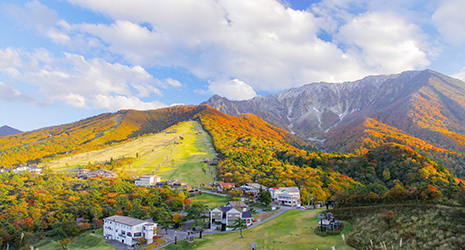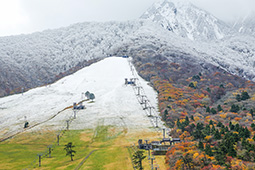INDEX
- English
- 日本語

Mt. Daisen in autumn viewed from the Mt. Goenzan Noroshi-dai Observatory - English
- 日本語

The Daisen Ring Road in autumn

Mt. Daisen viewed over the Sadagawa river from the Kinmon (Golden Gate) 
Mt. Daisen covered in colorful autumn leaves and a light dusting of snow
September 2021
Mt. Daisen Covered in “Seven Colors”

Mt. Daisen in western Tottori Prefecture is famous for its autumn leaves. In autumn, it is covered in richly colored leaves and the whole mountain is said to have autumn leaves of “seven colors.”

Towering 1,709 meters above sea level in western Tottori Prefecture, Mt. Daisen (its highest peak, Mt. Misen) is the tallest mountain in the Chugoku region of western Japan and one of the “100 Famous Japanese Mountains.” The mountain is sometimes called the Houki Fuji (“Houki” is the former name of the western half of Tottori Prefecture) because of its resemblance to conical Mt. Fuji when viewed from the west. When viewed from the north or south, by contrast, the mountain appears craggy with steep cliffs formed by eruptions and landslides when the mountain was still an active volcano. And a beech forest stretches out along the base of the mountain, making this a famous area for its striking views of the autumn leaves.
“The vegetation on the mountain is extremely abundant,” says Adachi Tomoko from the Daisen Tourism Organization, “and in autumn not just the beech, but oak, maple, Japanese rowan, and other deciduous trees change colors all at once. This is why the leaves turn shades of vermilion, orange, yellow, and more in the autumn, and the whole mountain is said to take on seven colors.”

According to Adachi, Mt. Daisen has been venerated as a sacred place in Japanese mountain worship since ancient times, and as entry to the mountain by ordinary people was strictly regulated until the early modern era, wide areas of nature remain untouched.
There are a number of particularly popular places from which to view the autumn leaves of Mt. Daisen. The about 900-meter-high Kagikake Toge Pass, for example, affords a sweeping view over the autumn leaves at the foot of the rugged southern face of Mt. Daisen. The Noroshi-dai Observatory, a viewpoint on the slopes of Mt. Goenzan, affords an unobstructed view of the northern face of Mt. Daisen. The Kinmon (Golden Gate), a natural opening between rock walls considered by mountain worshippers to be the “entrance” to sacred Mt. Daisen, affords similarly expansive views towards the mountain’s northern wall. There’s also an enjoyable view from the 64-km Daisen Ring Road, which circles Mt. Daisen on its slopes and passes through tunnels of trees with brightly colored autumn leaves.

The peak of the autumn leaf season is from the end of October through the start of November, when the temperature suddenly drops and winter approaches. At this time, it may be possible to enjoy magical scenes of Mt. Daisen with its colorful autumn leaves lightly covered in white snow.

